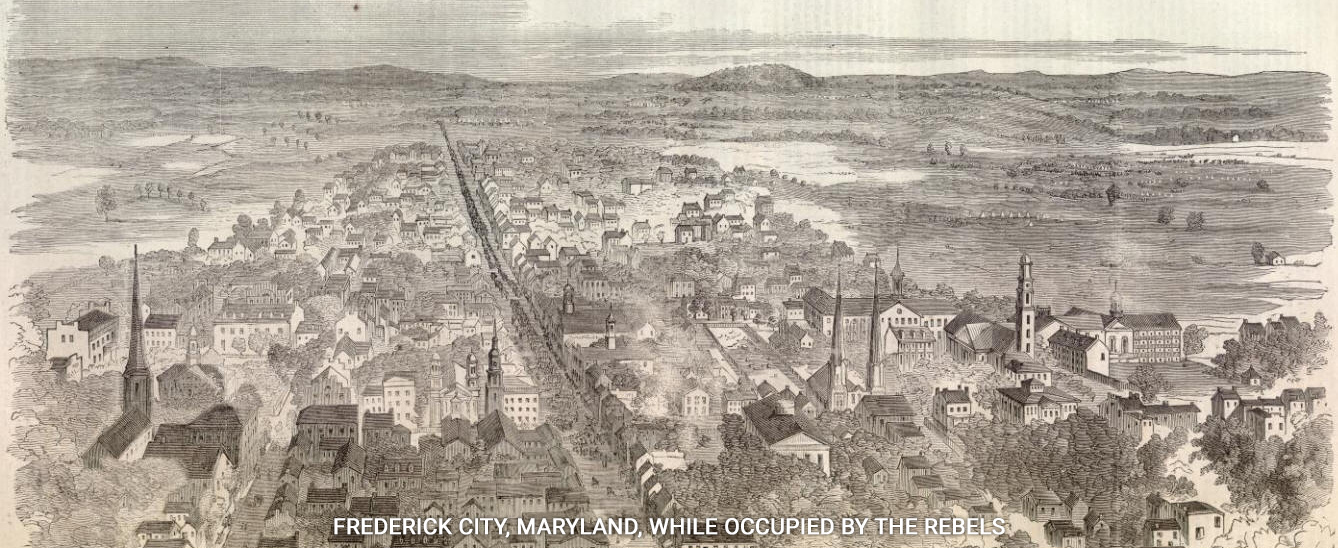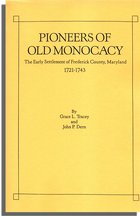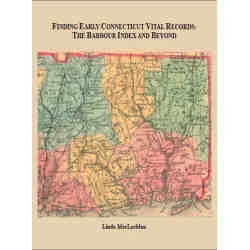
The American Society of Genealogists bestows its annual Jacobus Award upon the finest work of genealogical scholarship of the preceding year. It would be hard to find a more deserving winner of its coveted Jacobus Award than the 1988 selection, Pioneers of Old Monocacy: The Early Settlement of Frederick County, Maryland 1721-1743, by Grace L. Tracey and John P. Dern. A model of genealogical scholarship, Pioneers of Old Monocacy CACY should not only be on every Western Maryland researcher’s bookshelf but also on every genealogist’s “Top Ten” list for how to do research.
Pioneers of Old Monocacy was over 30 years in the making. The process began in the 1930s with Dr. Arthur G. Tracey, of Hampstead, Maryland. When Dr. Tracey turned his attention to the genealogy of Western Maryland, he discovered that the records of the, then, Maryland Land Office were in complete disarray. Hoping to create a picture of the original settlements of Frederick County (which, before 1748, included all of Western Maryland), the good doctor began the laborious process of tracing the original surveys of lands parceled out to Maryland’s original grantees. Tracey accumulated an enormous collection of parcel tracings, but, as John Dern has described, that was just his first step:
“Next came the process of discovering from reference clues in the surveys themselves where the land had lain and how the location of the various individual parcels related to such natural features as mountains, streams and roads, and how they all fitted together one parcel in relation to the others. Not to be forgotten either was the problem of careful referencing of all such diagrams to the original records at the Land Office itself as well as the construction of a system of map coordinates from which tissue tracings, card files and maps could be related to each other.”
Dr. Grace L. Tracey joined her father and, as his health declined, gradually took over the work. The younger Dr. Tracey decided to expand the scope of the project to include information about the settlers themselves. Accordingly, she began to research wills, court judgment records, rent rolls, and many other sources. The enormous number of drawings and sketches of pioneers she and her father had assembled compelled Grace Tracey to narrow her focus to the “Monocacy Valley and the mountainous country to the west, the area which eventually became Frederick County.” The late John Dern, of Redwood City, California, who shared a common research interest with Grace Tracey, became her collaborator until her death in 1972. Mr. Dern inherited Dr. Tracey’s very preliminary manuscript, “Notes from the Records of Old Monocacy,” which he continued to add to and refine until Pioneers of Old Monocacy was ready for publication in 1987.
The two Dr. Traceys’ and Mr. Dern’s achievement is remarkable in a number of respects. They had to reconstruct and establish relationships between land and other kinds of records that simply did not exist. Second, since their account of the Monocacy Valley precedes the separate existence of Frederick County, they had to resolve how to configure the area without the benefit of county, or for that matter, church records. Third, Tracey and Dern have, in fact, written the earliest local history of Monocacy Valley, one that supersedes earlier accounts. Fourth, anyone interested in the history of colonial land policy under the Maryland proprietorship will find an excellent summary within these pages, as well as numerous practical examples illustrated by the pioneers themselves. Finally, as noted earlier, they have given us a model for conducting genealogical research, which the condition of the records would suggest could not be done.
If you have an interest in Western Maryland genealogy or in the land records of the Free State, you may wish to consult the following titles, as well:
Settlers of Maryland, 1679-1783. Consolidated Edition
This volume consolidates Peter Wilson Coldham’s five-part series, “Settlers of Maryland.” Starting at the point where Gust Skordas’ famous “The Early Settlers of Maryland [1633-1680]” left off (see below), this work identifies all grants of land in Maryland made by purchase, a process involving the drafting of three distinct documents–warrants, certificates of survey, and patents. Entries in the consolidated edition are arranged by family name, county, name of tract, acreage, date, and reference to original sources. Altogether, approximately 20,000 landowners are named along with their numerous and vast tracts of land. View Book Details
The Early Settlers of Maryland [1633-1680]
An important historical and genealogical compilation, Skordas’ opus is an alphabetical index of over 25,000 settlers, virtually all of the immigrants to Maryland for its first 50 years. In addition to the immigrants’ full names, the work gives the approximate date of emigration, the basis of the claim for land, residence, sometimes the family relationship or status, and a reference to the source of the information. View Book Details
History of Western Maryland. In Three Volumes
This is a monumental treatise on the history of the western-most portion of Maryland, the area now comprising the counties of Allegany, Carroll, Frederick, Garrett, Montgomery, and Washington. The first half of Volume I surveys the periods of the French and Indian War, the Revolution, and the War of 1812, giving lists of early soldiers, settlers, voters, and public officials, with supporting lists of marriages, patents and surveys, churches, and institutions. The latter half of Volume I and all of Volume II give historical and biographical sketches, which include considerable genealogical data and are arranged by county and thereunder by district and neighborhood. View Book Detail
History of Frederick County, Maryland. In Two Volumes
The history of Braddock’s campaign, the local events of the Revolution, John Brown’s raid nearby, the old National Road, the earliest American railroad and its opening to Frederick, and the great events of the Civil War are all covered in the first volume of this monumental work. The second volume, “Biographical Record of Representative Families,” contains no fewer than 1,100 biographical and genealogical sketches, in most cases supplied by the subjects of the sketches themselves. Each sketch attempts to establish the origins of the subjects’ forebears, giving the dates and places of their birth, marriage, and residence, and facts concerning their immigration to and settlement in this country (most were of German or Scotch-Irish extraction). This monumental work is far easier to consult than ever, thanks to the Every-Name Index by Patricia Fogle. View Book Details





